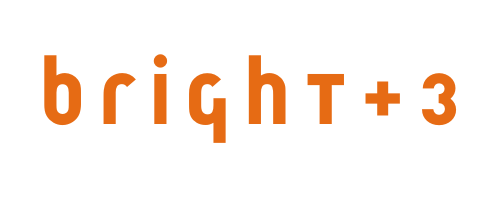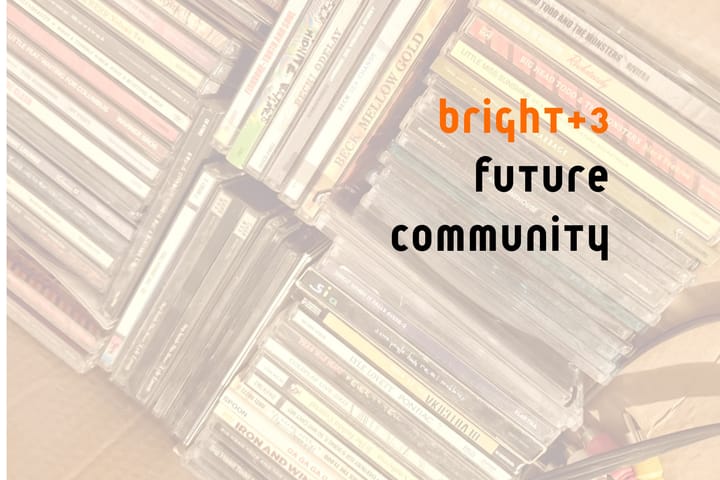Paddle, paddle, paddle!
The case for creation of content, emotion and emotion. More than ever, the content people consume guides their emotions, actions and politics. It also guides donations, loyalty and activism.
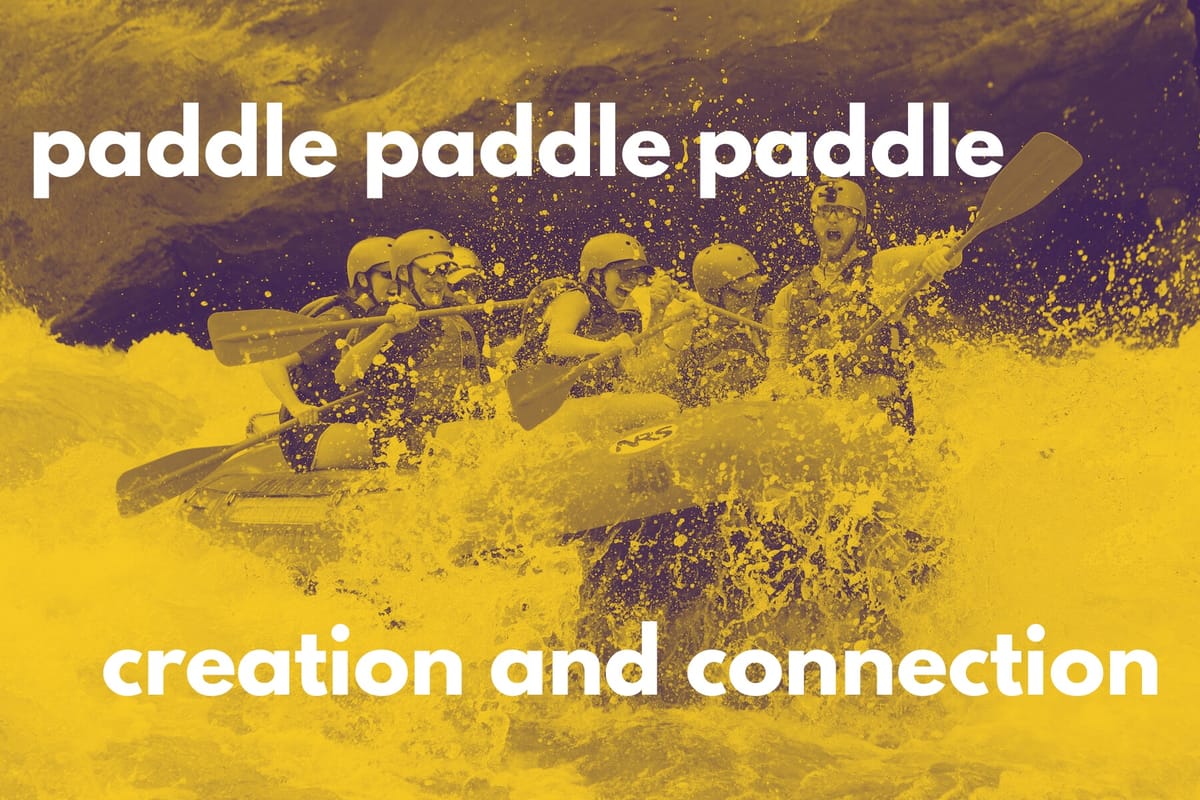
If you've ever spent the day or an afternoon on a rafting trip you know there's a feeling. It's something you hear first. A humming. A sort of white noise that gradually gets louder.
Chances are you have a guide and they're chatting away about something like the difference between Class III and Class IV rapids. Or it could be that you're lost in thought as you look out over the scenery as a hawk dives into the water downriver.
But, yeah, that swooshing sound is getting louder. What was that the guide said? "These are our first Class IVs of the trip. So pay attention to my directions."
And suddenly you can't feel, see or hear much of anything. The water is spraying all around you and maybe the back of the raft is tipping up into the air. Hey, that's where you're sitting.
Somebody somewhere (the guide? someone on the shore? who knows?) is yelling "PADDLE PADDLE PADDLE! LEFFFT! PADDLE PADDLE PADDLE."
And then all the sudden it's over. For some reason the roar of the rapids can't really be heard downstream of them. All you know is you're whooping and high fiving a bunch of strangers sitting next to you. And thinking "wow, I'm completely soaked."
It's a total rush. You either want to do this every day for the next week. Or maybe never again. But the emotions are high and when the raft pulls ashore a half hour later for lunch you can't stop talking about the experience with your new best friends.
A great raft trip, like so many experiences, is only memorable in the sharing. That's why guides ask people so many questions. Sure, they want to know if you're paying attention. But they're also trained to understand that people have more fun - and feel more - when they see others having fun, feeling it, experiencing something.
There's a similar drive towards shared experience and emotion that's driving success in our current media environment.
And if we want to keep people around, help them be sustainably loyal, have them vote or take action, and get them to donate more than once then this shared connection and emotion–this feel something together–needs to be a priority.
Retention - the money case for connection
One of my favorite data points in M+R's annual nonprofit fundraising benchmarks report is also one of the must boring and unchanging: online donor retention rates. Here's their chart of one-time donation retention rates in 2024.
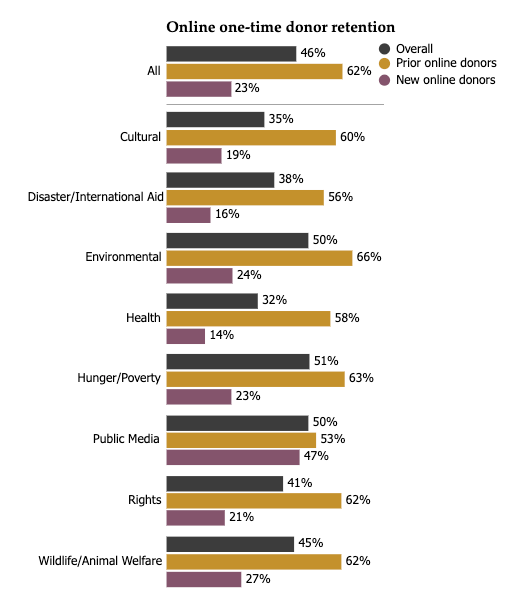
Last year’s online donor retention rates are more or less unchanged according to the latest M+R nonprofit fundraising benchmarks report.
The rates bounced around in the first years of the 2020s. Most likely due to COVID-19 and the rise in one-time that many organizations experienced in 2020 and 2021.
I went back further into older benchmarks reports. Overall retention rates have crept up since the 2017 report (which looks at 2016 giving data). Retention rates for new and prior year donors have remained largely the same. Here's my compilation of online donor retention rates over the past eight years M+R has tracked them.
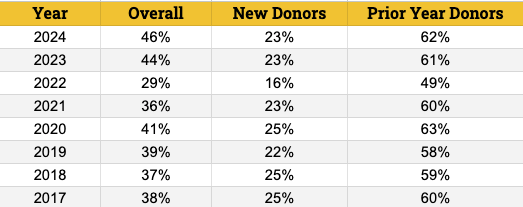
One lesson from the overall retention rate analysis is obvious: retaining a donor once greatly increases the odds they’ll continue donating again and again.
As a sector, nonprofit communicators and fundraisers aren't doing much to move the needle on new donor retention.
Maybe it can't be moved. Sure, it's harder to shift that number across a sector than in individual organizations. That's the burden of big numbers.
But I refuse to think the sector can't do better. And, in fact, the sector needs to do better if nonprofits are going to provide the level of service that's needed. And progressive organizations in particular have a huge challenge ahead of them. Nobody can afford passive supporters and donor churn.
A while back I wrote about churn (of subscribers, supporters, donors) and why people stay with you. Inertia and passivity and structural barriers explain a lot of why people remain in a situation (including on an email list). You forget about it. Or you just can't find the time or energy to get off the list. This is actually a not much talked about rationale for pushing monthly giving.
Another idea is that people stay with an employer, a home, a neighborhood because there's a sense of community. In a 2014 report on why people stay in their city or neighborhood, Richard Florida wrote: The main reasons why stayers stay, according to our analysis, revolve around social relationships and quality of place.
The hypothesis here is that donor (and subscriber, member, supporter, volunteer, activist) retention is in large part a function of connection.
Emotion. Socialization. Trust. Value. These are all elements of a strong community to which people feel connected.
I'm honing in on donor retention because it provides a financial argument for exploring and investing in community.
There may be myriad programmatic reasons for community. More money for programs is one of them. So is crafting a more engaged, vocal and powerful supporter base.
There is also a case to be made that connection and community provide a rationale for rethinking our approach to content, storytelling and media.
Creation and connection
You used to hear that Craigslist killed journalism because it took away classified advertising revenue. Don't believe me? See the 19 year old piece A Guy Named Craig in New York Magazine. Throughout the article the author, Philip Weiss, refers to Craig Newmark by the moniker "Exploder of Journalism."
Craigslist found a way to connect people with other people using an exchange of needs. Newspapers happened to fill that role for decades. But they wouldn't be able to do that forever.
Then Facebook ate journalism. And possibly killed democracy. They're still at it.
There may be myriad ways Facebook --> Meta is a bad company and not good for journalism, local news, and the businesses big and small that produce news. So many choices about algorithms, moderation and privacy could have been different.
But people were going to find ways to use the Internet to connect with other people. They still are.
Many of us like to point to platform companies (Meta, Facebook, TikTok, Substack, Twitter/X, Google) as the problem. They throttle our posts, force pay to play on us, change the algorithm, and stick their fingers in their ears when you talk about disinfo and moderation. All true.
But it's easy to obsess over the medium when your message isn't what people want to hear (or how they want to hear it).
Earlier this week, Andre Banks wrote about how the ways in which people consume media have more to do with the causes, politics, and leaders they identify with than our usual indicators of identity (e.g. race, class, gender). Banks concludes:
Because the next frontier of strategy isn’t just knowing what people believe.
It’s understanding how they come to believe it—and building systems that can meet them there, again and again.
For better or worse, people like Joe Rogan, Candace Owens and Ezra Klein are in or establishing systems that meet people where they are again, again and again. The visual conversations allow people to connect, one to one.
Richard Tofel, in today's edition of his Rough Second Draft newsletter, points out that a few creators have far bigger audiences (and influence? and impact?) than otherwise well know news voices and policy leaders:
College professor Heather Cox Richardson’s Substack newsletter “Letters from an American” now has more than 2.6 million subscribers. It’s hard to imagine how that doesn’t make her the most widely-read (and almost certainly also the highest paid) political columnist in America, today’s lineal descendant of Walter Lippmann and James Reston, leaving contenders like David Brooks in the dust.
In a more specialized news niche, for instance, the reach of Katelyn Jetelina’s Your Local Epidemiologist, also with about 370,000 subscribers (disclosure: a consulting client of mine) is almost certainly greater than most of the excellent pieces offered by STAT or KFF Health News. On Facebook, YLE has more than 400,000 followers, well more than STAT and almost 10 times as many as KFF, although STAT and KFF remain substantially ahead on Twitter.
Where do we go from here? The examples are out there in Richardson, Rogan, Jetelina and thousands of lesser known creators and news folks.
This is about something more than connecting with influencers and creators.
It's about connecting with your people - your audience - by both being creators and bringing people into the work, thinking, problems, wins, and losses.
PADDLE, PADDLE, PADDLE is a lot more interesting, memorable and successful when it's done with others.
